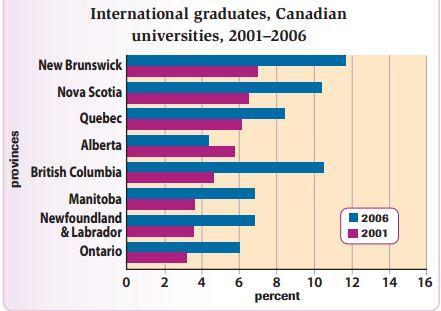The graph below shows the percentage change in the number of international students graduating from universities in different Canadian provinces between 2001 and 2006
The chart indicates the percentage of oversea graduate students from universities based on several regions in Canada from 2001 to 2006.
According to the chart, in 2001, the percentage of overseas graduate students per each region in Canada had only about 3-to-7 percent. Meanwhile, in 2006, this figure had increased by nearly 4.5 percent to 12 percent higher than those in 2001.
A more detailed look at the graph presents that New Brunswick had the highest percentage as a province in Canada where the percentage of international students achieved nearly 7-to-12 percent, followed by Nova Scotia and Quebec where came second and third in the all provinces both in 2001 and 2006. Interestingly, the percentage of universities in British Columbia had more doubled than that of 2001, from over 4% to nearly 10.5 %. This figure was the highest increase of the other areas in Canada.
Turning to the data presents that Manitoba, Newfoundland & Labrador and Ontario had a sharp increase percentage from 2001 to 2006. However, Alberta had the lowest percentage provinces in Canada with 5.9 and 4.2 percent in the same period.
To conclude then, there had an overall increase in the number of pupils who studied in the universities in Canada over the 5 years period, while the proportion of international students in Alberta depicted the reverse.
The chart indicates the percentage of oversea graduate students from universities based on several regions in Canada from 2001 to 2006.
According to the chart, in 2001, the percentage of overseas graduate students per each region in Canada had only about 3-to-7 percent. Meanwhile, in 2006, this figure had increased by nearly 4.5 percent to 12 percent higher than those in 2001.
A more detailed look at the graph presents that New Brunswick had the highest percentage as a province in Canada where the percentage of international students achieved nearly 7-to-12 percent, followed by Nova Scotia and Quebec where came second and third in the all provinces both in 2001 and 2006. Interestingly, the percentage of universities in British Columbia had more doubled than that of 2001, from over 4% to nearly 10.5 %. This figure was the highest increase of the other areas in Canada.
Turning to the data presents that Manitoba, Newfoundland & Labrador and Ontario had a sharp increase percentage from 2001 to 2006. However, Alberta had the lowest percentage provinces in Canada with 5.9 and 4.2 percent in the same period.
To conclude then, there had an overall increase in the number of pupils who studied in the universities in Canada over the 5 years period, while the proportion of international students in Alberta depicted the reverse.

canadian.JPG
